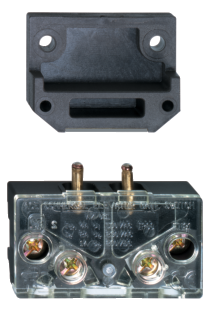Positive-operation door contacts
Archive

AZ 19
- Thermoplastic enclosure
- Contact pin in actuator bridge
- 2 actuating planes
- Protection class IP10
- Inseparable cover and enclosure
- Enclosure with mounting slots
- Self-cleaning through the frictional mouvement of the contact bridges
- fixing screws M4 undetachable, captive
Archive

AZ 5...
- Thermoplastic enclosure
- 1 Actuating planes
- Door lock switch/locking device switch
- transparent cover
- Contact pins in the switch
- double-break switch
- Self-cleaning through the frictional mouvement of the contact bridges
- fixing screws M4 Pozidriv self-forming, undetachable, captive
Area of application
The door contacts with positive break of the AZ series are available in ten different versions so that a suitable contact for monitoring the door position or the locking mechanism (hook bar) is available for all types of elevators. They are tested and certified in accordance with the European and American standards.
Design
With the AZ safety switches, the switching element and actuator are not connected to each other in terms of the design. However, when they are switched they are joined together functionally or separated. When the safety device is opened, the actuator is separated from the base device. In the process, the NC contact in the safety switch is opened through positive breaking.
Round or elongated holes serve to attach the switch; on some types, captive securing bolts are included in the scope of delivery.
The door contacts with positive break of the AZ series are available in ten different versions so that a suitable contact for monitoring the door position or the locking mechanism (hook bar) is available for all types of elevators. They are tested and certified in accordance with the European and American standards.
Design
With the AZ safety switches, the switching element and actuator are not connected to each other in terms of the design. However, when they are switched they are joined together functionally or separated. When the safety device is opened, the actuator is separated from the base device. In the process, the NC contact in the safety switch is opened through positive breaking.
Round or elongated holes serve to attach the switch; on some types, captive securing bolts are included in the scope of delivery.
.png?id=497683c97d2c2689df20070a5453bdbb)
